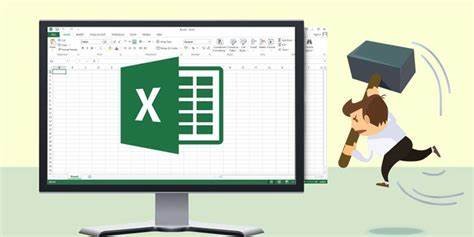
Microsoft Excel
Microsoft Excel is the popular Windows spreadsheet program that provides worksheets, charts, database and list operations, and application programming all in one software environment. It is used for managing, analyzing and presenting data in a graphical manner.Microsoft ExcelSpreadsheet is an application program that organizes data into rows and columns and allows the user to perform calculations on it. The spreadsheet has rows and columns. Each intersection of a row and a column forms a cell, in which you store data. Examples of popular spreadsheet packages are Microsoft Excel, Lotus 1-2-3 etc.
Advantages of MS-Excel:
- Ms-Excel is very easy to use.
- We can easily perform calculations by using different functions available in this program.
- We can work with two or more than two worksheets at a single time.
- We can represent data through different charts and graphs.
Starting MS Excel 2007
To start Ms-excel program, we should follow the following steps:
- Step 1:Click on the start button.
- Step 2:Move the mouse pointer over All Program Option.
- Step 3:Move the mouse pointer over Microsoft office option.
- Step 4:lick on the Microsoft Excel 2007.
Then the window appears on the screen.
Cell reference
Each row and column of the electronic spreadsheet has a specific name. Every rows and column are denoted by 1,2,3....and A, B, C.. respectively. A cell is the intersection point of a vertical column and a horizontal row. The name of a cell is given by the combination of row and column such as A1, D15 etc. In Excel, a cell reference identifies the location a cell or group of cells in the worksheet. There are three types of cell reference:
- Relative cell reference: Relative referencing means that the cell address changes as you copy or move it; i.e. the cell reference is relative to its location.
- Absolute cell reference: This means the cell reference stays the same if you copy or move the cell to any other cell. This is done by anchoring the row and column, so it does not change when copied or moved.
- Mixed cell reference: This means you can choose to anchor either the row or the column when you copy or move the cell, so that one change and the other does not. For example, you could anchor the row reference then move a cell down two rows and across four columns and the row reference stays the same.

merge cells in MS Excel
How to merge cells?
Merge cell is a function in the database software that allows multiple adjacent cells to combine into a single cell. This is done by selecting all cells to be merged and choosing the "Merge Cells" command. We should follow following steps to merge cells:
- Step 1: Select two or more adjacent cells that you want to merge.
- Step 2: Click on Merge & Center button situated at Home tab.
Filling Series
In Excel, fill handle is a command that lets you fill data into your spreadsheet cells, that is based on a pattern you establish. For example, you can use this command to continue a series of numbers, text combinations, or dates.
Steps for filling series:
- Step 1: Type two numbers in the cell from the sequential numbers.
- Step 2: Select both cells.
- Step 3: When you drag the cell to the right corner, the cursor changes into "+" symbol. This is called fill handle. If u click and drag the fill handle then you can get the numbers serially in different cells.
Use of formula and function in Excel
Use of formula and function
A formula in Excel is an entry that consists of values, address or range of cells, functions, and operators. A formula begins with (=) sign and returns the result in the cell where you enter it. The formula appears in the formula bar.
Functions are ready made formulas provided by Excel. They are calculation tools that make our work easy. Sum, Average, Min, Max are some of the examples of functions. Excel provides different types of functions such as arithmetic, logical, string, etc.
Sum () Function
This function adds all the numbers in a range of cells.
Syntax: SUM (number 1, number 2, ......)
Or,
SUM ( cell1, cell2, [cell3:cell4] )
number 1, number 2,...are arguments for which you want the total value or sum. It accepts maximum 30 arguments.
To calculate sum, following steps should be followed:
- Step 1: Click on the cell in which you want to carry out function.
- Step 2: Type "=" sign in the same cell.
- Step 3: Type SUM and '(' and range of the cells which are to be added. Then type ')' and enter to see the result.
- Step 4: If the same formula is to be used in other cells then click on fill handle and drag the mouse to those cells.
MIN () Function
This function returns the smallest number in a series of numbers.
Syntax: Min(number 1, number 2, ......)
number 1, number 2, ...... are 1 to 30 numbers for which you want to find the minimum value.
Follow the following steps to find the smallest number by using MIN function:
- Step 1: Click on the cell.
- Step 2: Type "=" and use MIN function.
- Step 3: Type MIN and '(' and range of the cells in which you want to find the smallest number. Then type ')' and enter to see the result.
- Step 4: If the same formula is to be used in other cells then click on fill handle and drag the mouse to those cells.
MAX () Function
MAX () returns the largest value in a set of values.
Syntax: MAX(number 1, number 2, ......)
Follow the following steps to find the maximum value by using MAX function:
- Step 1: Click on the cell.
- Step 2: Type "=" and use MAX function.
- Step 3: Type MAX and '(' and range of the cells in which you want to find the maximum value. Then type ')' and enter to see the result.
- Step 4: If the same formula is to be used in other cells then click on fill handle and drag the mouse to those cells.
AVERAGE () Function
This returns the average of the number.
Syntax: AVERAGE(number 1, number 2, ......)
Follow the following steps to find the average value by using AVERAGE function:
- Step 1: Click on the cell.
- Step 2: Type "=" and use AVERAGE function.
- Step 3: Type AVERAGE and '(' and range of the cells in which you want to find the average value. Then type ')' and enter to see the result.
- Step 4: If same formula is to be used in other cells then click on fill handle and drag the mouse in those cells.
IF () Function
If () function checks the condition and returns the TRUE value if the condition you specify is true and the FALSE value if it is false.
Syntax: If (logical_test, value_if_true, value_if_false)
If you want to calculate the result of a student by using If function, then follow following steps:
- Step 1: Click on the cell in which you want to calculate result.
- Step 2: Evaluate marks of different subjects by using If function.
- Step 3: Result is calculated according to marks obtained.
- Step 4: If the same formula is to be used in other cells then click on fill handle and drag the mouse in those cells.
Formatting
A properly formatted and better layout worksheets makes your information easier to read, more informative and attractive. You can format a cell or range of cells or the entire worksheet in many ways. Formatting includes font name, size of the font, alignment, borders, numbers etc.
The following figure shows the formatting tool bar:
- Step 1: Select the cell or range of cells where you want to change the font name.
- Step 2: Select the font name and size from the font group of home menu's ribbon.
Sorting
Sorting refers to the arrangement of the data records in the ascending or descending order on the basis of numeric or alphabetic fields.
Follow the given steps for data sorting:
- Step 1: Select the data which needs to be sorted.
- Step 2: Click on Data tab.
- Step 3: Click on Sort button.
- Step 4: Type criteria on the window.
- Step 5: If the selected data are header then tick on check box 'my data has header'.
- Step 6: Click on the sorting option A to Z or Z to A from the Sort & Filter group of Data menu's Ribbon.

Barchart in Excel
Chart in Excel
Ms Excel supports pictorial presentation of your data entered on a worksheet which is called chart. It is easy to understand numeric data by viewing in pictorial forms. Different types of charts supported by Ms-Excel are column, Bar, Line, Pie etc.
Follow the following steps to create a chart:
- Step 1: Select the range of data include in chart.
- Step 2: Click on the Insert menu.
- Step 3: Select on the Flayer menu of the Chart group from the Ribbon of Insert menu.
- Step 4: Select the appropriate Template for the graph.
- Step 5: Select the desired type of graph.
To change the types of chart
- Step 1: Click on available chart.
- Step 2: Click on change chart type button of design tab.
- Step 3: Windows with different charts are opened.
- Step 4: Click on required chart you want.
- Step 5: Then click on OK button.
To add title of chart
- Step 1: Click on available chart.
- Step 2: Click on chart tools layout tab.
- Step 3: Click on chart title button and select from the available option.
- Step 4: Then text box of chart title is opened. Type the suitable title for the chart.



